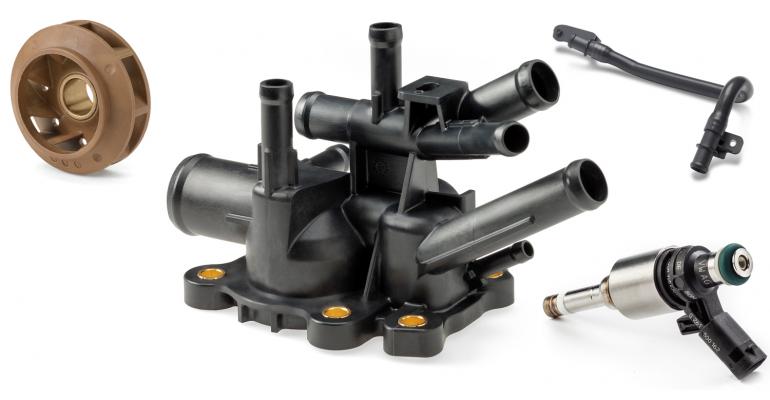Automakers are committing significant resources to develop electric, autonomous, and hybrid vehicles. These OEMs also need to meet rising demand for greater connectivity in every class of car, including vehicles with internal combustion engines. Automotive lightweighting, a design strategy that seeks to reduce vehicle weight, isn’t new. It has, however becoming more important for reasons beyond fuel efficiency and emissions reductions. Today, engineers want lightweight materials that improve design, manufacturability, and the performance of molded and machined parts.
For decades, automotive designers have been replacing heavier metal components with engineering plastics and fiber-filled composite versions. This practice is now broadening as automakers look beyond exterior components and interior fixtures. Thanks to advances in polymer technology, engineers have a wider range of new and lighter options for drivetrain and underhood components. Importantly, these materials offer greater design freedom and fit in well with the lightweighting strategies that go beyond replacing metal with plastic.
Thanks to their unidirectional carbon fiber optics and a high-quality surface offered by the polycarbonate matrix, Maezio™ continuous fiber-reinforced thermoplastic composites from Covestro bring a new tool to automotive designers’ toolbox for designing unique appearances. One case in point: they have given the ES8 and ES6, the all-electric SUVs from Chinese Electric Vehicle startup NIO, a boost on the wheels. At the K 2019 plastics trade fair from October 16-23 in Düsseldorf Covestro will present wheel blades made from this material.
New aesthetic, improved aerodynamics
The wheels feature aluminum rims with opt-in carbon fiber blade inserts, designed to lend the vehicle a high-end aesthetic appeal with a lightweight flavor and improved aerodynamics. What Maezio™ composites bring to the table is a combination of a unique appearance with unidirectional carbon fiber optics and a wide variety of finishing options. Further information on these products can be found here.
“Maezio™ composites are a very unique material because they kind of redefine how beauty is associated with carbon fibers,” says Yanbing Wang, Senior CMF designer from NIO. “They have set a new aesthetic direction with the unidirectional strands of fibers that remind me of the flowing shapes of rocks within the Antelope Canyon. It feels dynamic and full of energy.”
To achieve a high level of aesthetics, the choice of the resin system is crucial. Polycarbonates boast high surface quality and optical performance. Furthermore, polycarbonate-based composites are compatible with a wide range of coatings and decoration processes for designing unique surfaces. This makes it possible to develop a clear matt-coating system for the wheelblade that not only retains the beauty of the unidirectional fibers but also provides the needed protection – wheels are every vehicle’s touchpoints with the road, and as such, must perform flawlessly.
A technical breakthrough
Automotive exteriors exist in a harsh environment, and the requirements are demanding. Parts have to display high scratch-, weather-, ageing and chemical resistance properties. For wheel blades comes the additional requirement of high heat resistance during braking. So automotive exterior components not only have to look good after years of use but also perform on an everyday basis under tough conditions.
In combination with the coating system, the composite wheel blades have withstood rigorous safety and performance requirements, such as impact, chemical and weather resistance. The Makrolon® polycarbonate on which Maezio™ is based displays high thermal stability qualities so the wheel blade insert can survive braking-induced temperatures of up to 150° C.
A seamless integration
For composites to be widely adopted in automotive they also need to be easily integrated with other materials in a multi-material system. Because of their thermoplastic matrix system, Maezio™ composites can be easily joined with functional components during processing, e.g., through back injection molding. In the case of the wheel blade inserts, they are joined with the aluminum spokes of the wheel through back-molded screw bosses made of polycarbonates. The common resin material makes it easy and secure to bond the two parts.
A second life
Car manufacturers are under pressure to make their vehicles less environmentally impactful. Electric vehicles are ahead of the curve, and so it’s natural that EV manufacturers are on the lookout for materials that are easy to recover and recycle.
Maezio™ composites can be cut and remelted for reuse at the end of life, or reground into short fiber compounds and used in an injection molding process, making them a sustainable material choice for EV manufacturers to further improve their sustainability scorecard.
“We have proved with this major breakthrough that Maezio™ composites are a technically and commercially viable material solution in automotive exterior applications,” says Lisa Ketelsen, head of the thermoplastic composite business of Covestro. “The end result is a newly defined aesthetic direction and benchmark for thermoplastic composites in automotive. We look forward to helping the automotive industry scale new heights with the benefits thermoplastic composites have to offer.”
SOURCE: Covestro




Leave a Reply
Want to join the discussion?Feel free to contribute!